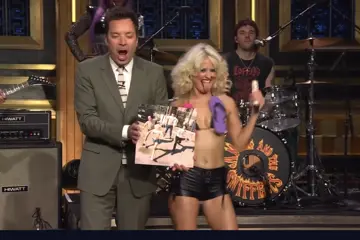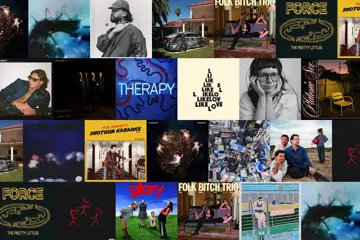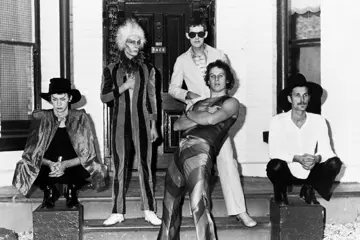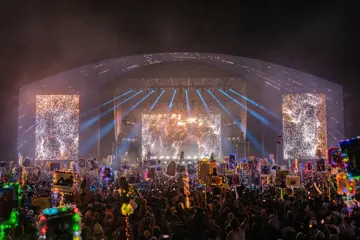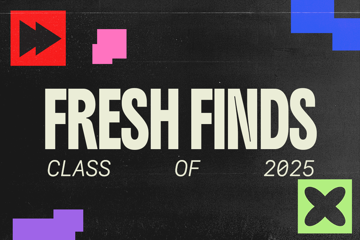 Men At Work
Men At Workpreviously: part one
Melbourne’s music scene in 1980 was even more promising than Liverpool’s had been twenty years earlier.
Where British groups like the Beatles looked mainly to the United States for their inspiration, ambitious rock’n’rollers in Australia’s southern capital mined gold from both sides of the Atlantic and from a further decade of material produced over the innovative seventies. Unlike the ‘beat bands’ era in Britain, the popularity of pub rock in Australia denied the idea of restrictions on what a commercial pop song could sound like. As long as it had energy and a memorable melodic component, we wanted to hear it. When it came to the latest trends, the Poms and the Yanks were ahead of us, but not by much.
One imported tune in particular, a mid-paced ballad from Gerry Rafferty, would have a great influence on Men at Work. Appearing on our radios in 1978, ‘Baker Street’ is an easily accessible story-song coloured by synthesised strings and woodwind, electric piano, congas, a sweetly overdriven guitar solo and a strong counter-melodic bassline. But what stands out is the signature eight-bar alto sax theme that appears three times during the verses – itself a piece of pop history that’s become so famous, it even bears the weight of some mischievous controversy regarding who actually played the notes on the recording.
When you reference this song, it’s the saxophone that you’re recalling. During the ‘synthesised’ eighties, the sax would undergo a memorable pop revival, featuring in countless hit songs by artists as diverse as INXS and Tina Turner, Duran Duran and George Thorogood. Arguably it would become overused, even abused and stripped of its warmth as the last genuine piece of acoustic hardware in the electro-pop arsenal. By the start of the grungy, iconoclastic nineties, this powerful and expressive instrument that had come across enthusiastically from jazz would be consigned to the fashion throw-out bin. But that was still years, and half a dozen pop trends, away. For the moment Ham, a self-taught woodwind player, was certainly listening to ‘Baker Street’ and no doubt loving it.
The saxophone wasn’t the only recent trend that Men at Work used to their advantage. Western pop has always absorbed a range of styles, from blues to country, folk to classical – even Latin, African and Indian influences have left marks. During the late seventies, many hit-makers were turning their attention towards the West Indies for inspiration. Reggae was shuffling its slow grooves across the Caribbean islands in a laidback expression of a marijuana and ‘mañana’ culture. It was also a forum for any player with an ideological barrow to push, with black Jamaicans – notably Bob Marley, Peter Tosh and Junior Marvin – railing against the status quo from behind their guitars.
In Britain, street violence from right-wing forces provoked a musical counterattack. Whether or not their local legislators worried about where the nation was heading, London’s leading garage rockers, the Clash, certainly did. Their 1977 self-titled debut album set the standard for political punk, and many songs had a reggae sound. Nevertheless, as much as the music of Kingston inspired them, a 1978 recording trip to the Caribbean left the band in no doubt as to the relative security of their motherland. In ‘Safe European Home’, Joe Strummer tells of how whites in Jamaica can be sitting ducks for criminals on the prowl. Also in 1978, prog-pop band 10CC would cover crime and fear aspects of a visit to Jamaica in ‘Dreadlock Holiday’ – which, no doubt due to its memorable chorus with an amusing reference to cricket, would ironically or otherwise earn a place in the canon of classic pop songs.
In the wake of these hits, white boy reggae began to infiltrate the US music markets as the Americans slowly began to open up to the many novelties riding the new wave. Nobody did as much to precipitate this as a London musical trio, the Police. Although they arrived with and traded on the punk-rock revolution, they were never wholeheartedly in that musical camp. Americans may have mistaken their trademark spiky bleached hairdos and black leather as signs of something more punk, but the British knew where these guys had come from: jazz, prog rock and electronica.
Where most punk music was constructed over guitar power chords in major scales with the accent on the first and third beat of the bar, the trademark Police sound features a bouncy bass groove beneath extended and minor chords accenting the second and fourth beats. Pre-choruses and choruses were crafted to be energetic and hook-filled through reversion to more typical rock-pop rhythms. In other words: we got reggae but, in this case, without the soporific reefer. Chart success wasn’t immediate, but what the Police created would soon prove to be a winning formula. After overcoming a false start, a re-released cut of their first single, ‘Roxanne’, pushed its way towards the top of the British playlists and over halfway up the US Billboard as well. The Police also paved the way for a little Aussie outfit called Men at Work, whose second big hit was more than slightly Caribbean in feel.
The earliest incarnation of ‘Down Under’ is pure white boy reggae. Instead of the now familiar flute line as opening, Rees leads off with a very similar intro melody played on the bass guitar. The tempo is noticeably slower and the drums don’t come in until a roll at the seventh bar. In contrast, the well-known version of the tune kicks off with Jerry Speiser’s tom-toms punching out. Listen to the old proggy recording – itself the B-side of their first single – and the next surprise is the timbre of the vocals: Hay sounds like he’s singing through a primary school PA system. In fact, his vocals have gone through an equaliser or sound filter that has diluted the rich tones we know he can deliver. The early cut is a kind of thin, flat, distant or dreamy effect, perhaps analogous to a mental dope haze, reflecting themes touched on in the second line of the lyrics. It’s not a long bow to draw, given that much of Caribbean reggae at the time was a celebration, or at least created under the influence, of the notorious weed.
Further contrasts with the later, poppier incarnation of ‘Down Under’ are evident. The old take has Hay almost talking or rapping the second part of the chorus. Until over a minute into the song, we’ve heard no flute at all, and instead we get Strykert’s short guitar fills. Initially these feature harmonics and heavy delay in the style of Andy Summers from the Police, and later short pentatonic scales, not a long way from the tone and phrasing that characterises Mark Knopfler’s work on the 1978-released and hugely popular single ‘Sultans of Swing’. By the time we get to the end of the second verse, the rhythm guitar pokes through in an offbeat groove with staccato feel, all muted downstroke with treble chords on the upstroke strings. Summon to mind here Elvis Costello’s playing as he draws us into the minor-keyed verses of ‘Watching the Detectives’, another example of crossover reggae emerging from the British new wave.
Perhaps the greatest difference between the familiar, straight-ahead pop recording of ‘Down Under’ and the old B-side arrangement comes at the breakdown, when the band suddenly launches into a two-chord vamp whose melodic shape and mood bring to mind a medieval jig. With an obvious nod to the British prog folk movement of the early seventies, the flute comes into its own here, doubling the bass or trading licks with the lead guitar. While in this early version Ham does, at one point, seem to include references to an old Australian round called ‘Kookaburra Sits in the Old Gum Tree’, the contribution consists of no more than a pair of three-second quotes. Neither the instrumental break nor the flute or guitar colourings throughout the rest of this demo cut of ‘Down Under’ show any sign of Australia’s famous laughing gumtree dweller. In fact, if there is such a thing as an ‘Australian sound’, it certainly isn’t obvious when you listen to this track. Remove the lyrical references and the tune could have come from anywhere on the planet.
Reggae pop, when done well, is a no-brainer as far as sales potential. Even artists as established in their respective genres as Led Zeppelin, Elton John and Eric Clapton have let sprout their musical dreadlocks in the cause of easy chart success. Like any smart songwriter, Hay was listening to and absorbing everything on the radio. Sounds were important, melody even more so. Industry people know that in order to achieve a killer single, you also have to create an image or story that will sell the tune. As yet, Men at Work hadn’t nailed that part. Although the early recording of ‘Down Under’ was undeniably more interesting than its A-side partner, the eccentric, laid-back reggae tune about the adventures of an Aussie abroad still needed the attention of a good producer and some clever marketing. And while this drug-themed number remained a staple of the band’s set list, no one outside the Melbourne pub circuit would hear the song until the Men could secure themselves a record contract.





